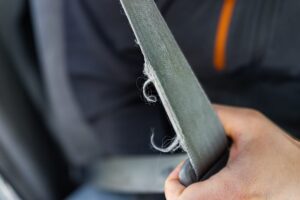Request your Free Consultation
Posted on January 30, 2025 in Personal Injury

Bent bumpers, broken glass, and crumpled hoods – obviously, these parts must be replaced following a car accident. But what about other, less obvious components that also undergo stress in a collision – namely, the seatbelt?
Seatbelts are crucial safety devices, but can they continue to work as intended after a car crash that puts the equivalent force of a three-story fall on their mechanisms? Should seatbelts be replaced after an accident?
Seatbelts protect vehicle occupants by keeping them restrained and in their seats in the event of a violent collision. Without proper safety restraints, the force of a crash can send a person through the windshield or slamming around the interior.
Modern seatbelts use a retractor mechanism. The durable fabric webbing of the seatbelt feeds through a spool and retractor mechanism, typically housed inside a plastic shell. A locking mechanism in the spool stops it from rotating in certain situations. Under normal conditions, the spool is slack, so you can pull the seatbelt around yourself and still move fairly freely. However, quick deceleration or jerking motions trigger the retractor, preventing the spool from rotating. This mechanism keeps the belt from loosening, securing you firmly in your seat.
How effective are these ubiquitous safety devices? The National Highway Traffic Safety Administration(NHTSA) estimates that seatbelts saved at least 14,955 lives in just one recent year.
The violent deceleration in a crash triggers a reactor mechanism to lock the spool of the seatbelt. The force prevents the internal mechanism from rotating and loosening the belt. The belt locks and restrains the person against the seat, keeping the torso, shoulders, and hips of the body in place.
Although seatbelts protect people in the event of a crash, seatbelt mechanisms can wear down over time. Following a collision, the seatbelt’s mechanisms may be compromised and unable to function correctly.
A car accident can compromise the integrity of a seatbelt and its internal mechanisms. The next time you need it, the seatbelt may not offer the protection you expect.
Some newer vehicles have seatbelts that communicate with the car’s airbag system. Following an accident, these sensors can be damaged and reduce the safety devices’ effectiveness. Crashes can also damage the belt’s locking mechanism and the spool and cause wear and tear on the fabric of the belt. That’s why many organizations, including NHTSA, recommend you replace seatbelts after an accident.
Seatbelts are critical safety tools that can save your life. Never compromise your safety or that of your passengers. After an accident, get your seatbelts replaced and ensure they are in good working condition when you get your car back.
Has a careless driver injured you in a Greenville car accident? Discuss your situation with an experienced personal injury attorney at The Melonakos Law Firm today. We have achieved hundreds of favorable verdicts and settlements over the years, and we are eager to show you what we can do for you.
Contact our Greenville office to set up a free consultation.

Michael Melonakos is a Greenville-based personal injury attorney known for his experience representing both accident victims and major insurers. After years with top Atlanta defense firms, he now uses his insider knowledge to help Upstate clients maximize their injury claims. Michael is committed to compassionate service and is actively involved in the Greenville community.